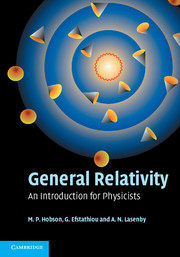Book contents
- Frontmatter
- Contents
- Preface
- 1 The spacetime of special relativity
- 2 Manifolds and coordinates
- 3 Vector calculus on manifolds
- 4 Tensor calculus on manifolds
- 5 Special relativity revisited
- 6 Electromagnetism
- 7 The equivalence principle and spacetime curvature
- 8 The gravitational field equations
- 9 The Schwarzschild geometry
- 10 Experimental tests of general relativity
- 11 Schwarzschild black holes
- 12 Further spherically symmetric geometries
- 13 The Kerr geometry
- 14 The Friedmann–Robertson–Walker geometry
- 15 Cosmological models
- 16 Inflationary cosmology
- 17 Linearised general relativity
- 18 Gravitational waves
- 19 A variational approach to general relativity
- Bibliography
- Index
8 - The gravitational field equations
Published online by Cambridge University Press: 05 September 2012
- Frontmatter
- Contents
- Preface
- 1 The spacetime of special relativity
- 2 Manifolds and coordinates
- 3 Vector calculus on manifolds
- 4 Tensor calculus on manifolds
- 5 Special relativity revisited
- 6 Electromagnetism
- 7 The equivalence principle and spacetime curvature
- 8 The gravitational field equations
- 9 The Schwarzschild geometry
- 10 Experimental tests of general relativity
- 11 Schwarzschild black holes
- 12 Further spherically symmetric geometries
- 13 The Kerr geometry
- 14 The Friedmann–Robertson–Walker geometry
- 15 Cosmological models
- 16 Inflationary cosmology
- 17 Linearised general relativity
- 18 Gravitational waves
- 19 A variational approach to general relativity
- Bibliography
- Index
Summary
Let us now follow Einstein's suggestion that gravity is a manifestation of spacetime curvature induced by the presence of matter. We must therefore obtain a set of equations that describe quantitatively how the curvature of spacetime at any event is related to the matter distribution at that event. These will be the gravitational field equations, or Einstein equations, in the same way that the Maxwell equations are the field equations of electromagnetism.
Maxwell's equations relate the electromagnetic field F at any event to its source, the 4-current density j at that event. Similarly, Einstein's equations relate spacetime curvature to its source, the energy–momentum of matter. As we shall see, the analogy goes further. In any given coordinate system, Maxwell's equations are second-order partial differential equations for the components Fµν of the electromagnetic field tensor (or equivalently for the components Aµ of the electromagnetic potential). We shall find that Einstein's equations are also a set of second-order partial differential equations, but instead for the metric coefficients gµν of spacetime.
The energy–momentum tensor
To construct the gravitational field equations, we must first find a properly relativistic (or covariant) way of expressing the source term. In other words, we must identify a tensor that describes the matter distribution at each event in spacetime.
- Type
- Chapter
- Information
- General RelativityAn Introduction for Physicists, pp. 176 - 195Publisher: Cambridge University PressPrint publication year: 2006



